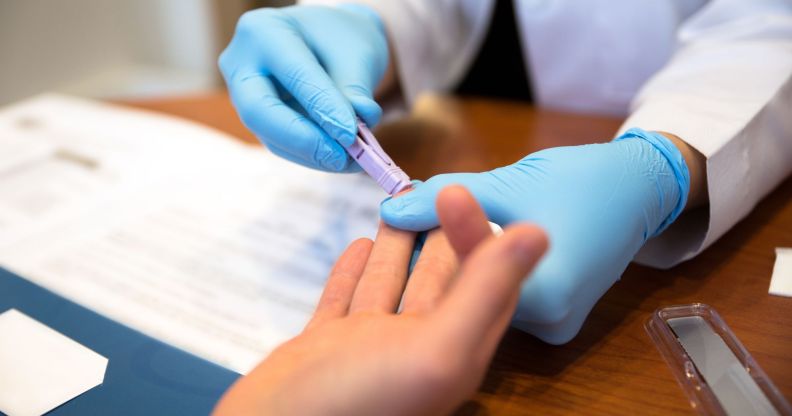Heterosexual HIV infections overtake gay and bisexual cases in Scotland

Person getting a finger-prick HIV test. (Getty Images)
New HIV transmissions among heterosexual people in Scotland are higher than for gay and bisexual men for the first time in 10 years.
According to figures released by Public Health Scotland on Tuesday (26 September), 42 per cent of new HIV diagnoses in Scotland last year were among heterosexual people, compared with 29 per cent among gay, bisexual and other men who have sex with men (GBMSM).
The figures also showed a 13 per cent increase in new diagnoses among straight people since 2019.
This follows statistics released in last year that showed the same trend throughout the UK, with straight people making up almost half (49 per cent) of all new HIV diagnoses in England in 2020, a greater proportion than GBMSM (45 per cent).
The Terrence Higgins Trust (THT) pointed out that while GBMSM are “more impacted by HIV, relative to population size”, there has been reduced new transmissions within this community due to the successes of interventions such as pre-exposure prophylaxis (PrEP), the medication that can prevent someone contracting HIV.
The charity said that PrEP, accessible HIV testing, the availability of condoms, and people living with HIV’s adherence to treatment, have all helped to secure a 37 per cent decline of new HIV diagnoses among GBMSM in Scotland since 2017.
Public Health Scotland’s figures also showed that levels of late-stage diagnoses were slightly elevated among straight people, with 27 per cent of heterosexual people being diagnosed at a late stage, compared with 23 per cent of GBMSM.
THT added that in order to combat this, the government must commit to increasing HIV testing in Scotland, as well as improving access to PrEP.
“Today’s statistics show that Scotland is making progress on ending new cases of HIV by 2030, but we won’t get there by accident,” said Alan Eagleson, the head of Scotland services at THT.
“The clock to 2030 is clicking, and while today’s statistics show some progress, more must be done to ensure that equitable progress is being made and that no communities are left behind.
“Scotland can – and should – be the first country in the world to eliminate new transmissions of HIV, and Public Health Scotland’s data shows some progress towards this goal.
“The Scottish government must now set out a clear action plan that delivers on Scotland’s 2030 HIV ambition.”
England has also set a goal to end new HIV transmissions by 2030. However, experts have called into doubt the likelihood of achieving this, with THT urging the UK government to expand opt-out HIV testing programmes.
Richard Angell, THT’s then campaigns director, told PinkNews in 2022 that the success of opt-out testing programmes in London, Brighton, Blackpool and Manchester proved the need to expand testing across the UK.
“Government guidance is that everybody who goes to A&E in a high-prevalence area should be tested automatically for HIV. They’re already taking your blood, there should be an automatic HIV test,” he said.
“The funding is only there to do that in the very highest-prevalence areas, but there are places – whether it’s Luton, Leicester or Leeds, whether it’s Bournemouth or Birmingham, Sandwell or Southampton – where this testing is not yet happening.”
According to the charity, estimates suggest that 106,890 people are living with HIV in the UK as of 2019, with 95,900 people estimated to be living with HIV in England as of 2021.
How did this story make you feel?

